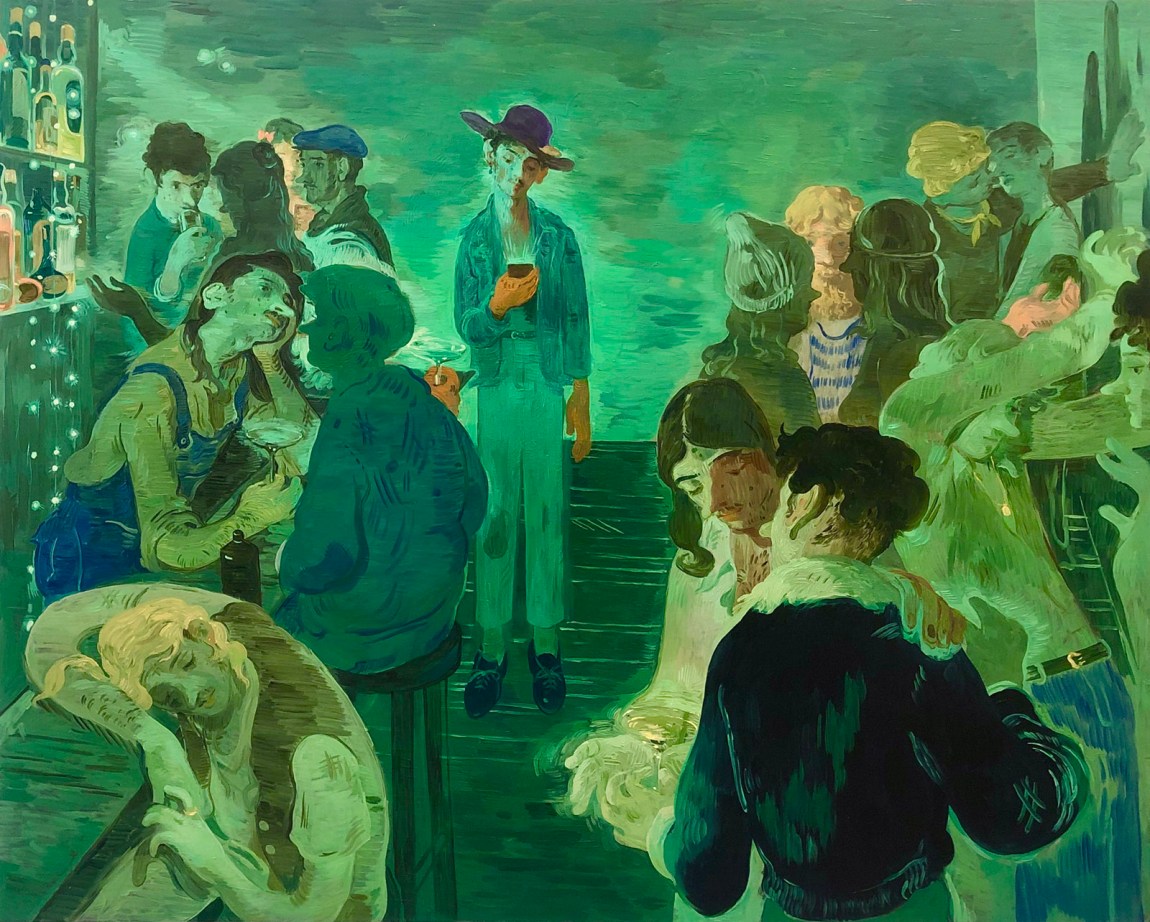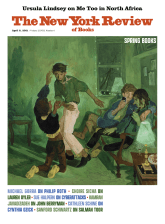The spirit and appearance of Jesus Christ and of Pinocchio, two figures who are rarely found in the same sentence, both can be felt in Salman Toor’s paintings, currently the subject of a show at the Whitney Museum of American Art. These deliciously painted and mostly small-to-medium-size pictures, done in the past few years, seem to follow the doings and observations of one young man, though many of the figures in the scenes, which might be set in a bar, on a stoop, or in an apartment, are young men who resemble one another in build. They are willowy and they often sport scraggly dark hair. Many exude a gentleness and sweetness, a demeanor that, along with the shoulder-length hair of some of them, recalls the young Christ in certain canvases by Rembrandt. Oddly, most have long and pronounced noses, which can make us think of Pinocchio even if it is hard to see a link between Carlo Collodi’s mischievous, mishap-prone boy hero and the “boys,” as Toor calls them in his titles.
But then surprising associations with current and past artists, and an unusual predilection for a single color, are also part of the rich and quirky experience that is Toor’s exhibition. Entitled “How Will I Know,” which derives from the popular Whitney Houston song of the same name, it is the first museum show of a relatively young artist who has been exhibiting in New York in recent years but who seems to be barely known even by viewers who keep up with the latest developments. This makes all the more substantial what Toor—who was born in Pakistan in 1983, came to this country for college, and has lived since 2006 in New York City—has accomplished.
His subject in the broadest sense is gay life: its pleasures, tensions, small moments, and realizations. The fifteen paintings in the show are loosely structured around our young man, who is dark-complexioned (and whom we might think of as the artist). In a few pictures he is merely one of the figures in the scene, some of whom also have brown skin, though others appear white. In other works he has the presence more of the protagonist. Whatever this character’s significance, Toor’s pictures form a kind of overview of the situations that many gay men enjoy or endure. Four Friends, for instance, presents two young men dancing in a city apartment. Our man, who is wearing light-colored pants and doing the twist, stands out in the dimly lit, largely green room, while two other friends snuggle on a nearby sofa. Puppy Play Date takes us into another living room, where two rather thin young men watch as their dogs are entangled with each other.
Elsewhere, Toor looks at the hazards of being openly gay in some circumstances. Car Boys gives us two fellows in a car at night who have had their privacy invaded by policemen; one, leaning in, shines a bright light at them. And in The Smokers, some men outside what might be a gay bar, clearly happy and assured in being together, don’t see a wary-looking policeman who is coming their way. Toor does not shy away from private moments, either. Bedroom Boy gives us a nude young man on a bed who is taking a photograph of himself with a smartphone, while in Sleeping Boy a male nude, adorned with jewelry and languorously stretched out on a voluptuous mound of bedding—a male odalisque, in effect—has fallen asleep with a nearby computer on, light streaming forth from it.
What makes these pictures distinctive and absorbing is that while homosexuality is hardly new to art, Toor brings a sense of soft-spoken, ingenuous, everyday intimacy to this material that feels new. At the same time, for all his contemporary candor about showing men in love with each other, and despite the up-to-the-minuteness of the smartphones and computers that his characters regularly use, Toor’s way of painting is familiar. It is a kind of straightforward representational art—one that, to my eye, seems to echo aspects of classic French painting.
The young man at the right side of The Smokers, for example, who wears a hat and looks questioningly up into the scene, recalls one or two similar observers in paintings by Renoir. The sometimes swarthy fellows in Toor’s pictures, with shawls over their shoulders and kerchiefs around their necks, could be stepping out as well from Delacroix’s Middle Eastern hothouse world. In its romantic celebration of sensuality, Sleeping Boy also has more life in it than Delacroix generally achieved. And the mysterious prevalence of green—green on the walls and floors and suffusing tables and lampshades—made me think not only of Vuillard’s green-filled 1891 interior The Flowered Dress but of how Vuillard could make the colors of a room into part of a picture’s story.
Advertisement
A wall label at “How Will I Know” calls the paintings “cartoony,” and a cartoon style partially explains the elongated and seemingly boneless nature of the bodies we see (and their noses). Hands, elbows, and arms in particular can be rubbery, though they are nevertheless at home with the rhythmic curves of the nearby forms. But cartoons do not account for the liquid, restless, and quietly luscious nature of Toor’s oil-paint surfaces.
Whether he is showing blue jeans, a martini glass, or a person’s hair, Toor makes it seem as if he has brushed it in just a moment before. If he wants to show light descending from a lamp, he paints it in so many white, vertical, parallel strokes. If our sleeping nude has hairy legs, black flecks here and there will suffice. Every aspect of a given picture seems to breathe a little. Even walls look as if they have a pulse, and with certain figures—say, the shy, Christlike young man at the door in The Arrival—the light in the background, coalescing around his head, forms a kind of halo.
There are unexpected notes in many of the pictures. One of the cops in Car Boys, for example, has a big belly, which he sticks toward the boys in the car. This ought to be menacing, but his threat is mitigated by the un-cop-like way he frames his paunch, with his hands turned backwards on his hips. (It put me in mind of a matriarch coming out of her kitchen to survey the feast she has made for her family.)
Stoop, a five-foot-high vertical painting, makes us pause and wonder what it is about. It shows a young man descending the steps of the sort of anonymous downtown rowhouse that suggests the era of the Ashcan School artists. A dropped ice cream cone is melting on the sidewalk and a cat is in the window. At the base of the steps there are two men who are lovingly touching each other. With their costumed appearance, they need only a guitar to become wandering troubadours in an operetta. One of them is capturing their romance with his smartphone. There is a possibility, though, that the figure coming down the steps, who is probably our main man and who eyes the lovers as he descends, is imagining them. The thought gives the picture a second life, and it occurs to the viewer because other pictures have a dreamlike uncertainty, too.
This is the case with Tea, one of Toor’s most engrossing works. In it, a young man comes upon his family (or so we assume) having tea at a table. We believe that this man is the fellow we have been following all along, except that his hair, which generally has had a roughened look, is now plastered down and parted. He stands ramrod straight, perhaps acting out being brave, or at least impassive. He faces his parents and two sisters, and the way he seems to have materialized out of the wall behind him makes one wonder whether the scene might be his dream.
Each of the family members is registering another feeling, and Toor’s sense of characterization, done with the slightest means, is amazing. One sister, looking at her brother, is noncommittal but might be quietly happy for him. Her sister, her eyes down, probably wishes the moment were over. Father (or possibly a visitor) is turned inward and not connecting with anyone. Mother is beautifully realized. She has been part of the tea party and is now reaching out for the fruit. To see her son, who has just arrived, she also turns toward him, which means she is seeing him sideways. It is a particular twist that indicates that she is in two camps at once. Her body language says either “Dear, here you have come” or, coolly, “Oh, it is you.” Her turned body, with its implication of strife, encapsulates the entire moment. Inventing it, Toor joins the company of Mark Greenwold and Eric Fischl, long-standing masters of picturing familial and domestic crises.
Bar Boy takes viewers aloft in another way. At four feet high by five feet across, it is the largest work in the show and a feat of planning and design. The bar boy is presumably the fellow who stands by himself in a space in the center, communing with his smartphone, which beams light out at him. On either side are people, primarily men, who are conversing, looking into one another’s eyes, sleeping, biding their time, or about to kiss. Most of the picture is in shades of green, and our eyes eat up Toor’s phenomenal skill in two things at once: making one color have such variety, and creating some sixteen separate figures, almost all his or her distinctly own person, with bodily shapes and haircuts to match.
Advertisement
The only weak link is the young man with the phone. As the picture’s centerpiece, he is a little lacking in presence, and the space around him feels blank. But if this section of the picture is not quite right artistically, it possibly adds a note to the show as a whole. Maybe our man is being carried along by “How Will I Know” and, traveling on the song’s wavelength, has left this scene entirely.




